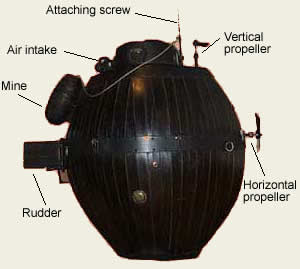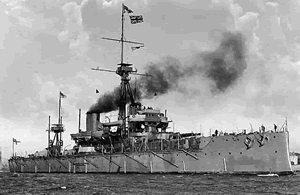Inception of the submarine
In 1775, David Bushnell invented
the first submarine . Built of oak beams, it resembled two turtle shells
joined together, as pictured on the right. It was known as the American
Turtle. Click to see a 300 Kb video of its
operation.
Although its attempt to sink the H.M.S. Eagle, the 64 gun flagship of
the British fleet, was unsuccessful it represented the birth of the submarine,
the most powerful naval weapon in history.
It had air reserves for 30 minutes of underwater operation. It would travel approximately 3 metres below the surface propelled by hand-powered propellers. It would then drill a hole into the hull of the enemy ship and attach a high explosive mine.

In 1907 the Royal Navy launched,
what was widely regarded as the ultimate naval weapon, HMS Dreadnought.
Counter measures for this naval weapon included building bigger and
better Dreadnoughts and many nations embraced the idea of the development
of huge vessels to counter British dominance of the seas.

John Holland, an Irish patriot, saw a solution to the British naval supremacy in a small submersible vessel. On May 17th, 1897, Holland, as pictured on the right, displayed his perfected design publicly, hoping to attract government funding. His design included, periscope, torpedoes that could be propelled by compressed air motors, ballast tanks for diving, gasoline engine for traveling on the surface and a battery powered engine for underwater travel.
Holland's submarine spent four hours surfacing, diving and even fired a torpedo which hit its mark at a range of just under 300 metres. The U.S. Navy and the Royal Navy showed little interest, but the German Kriegsmarine were very enthusiastic in the idea. Shortly after Holland's demonstration the Germans purchased the licenses for his design.
Seventeen years later, on September 21, 1914, the German submarine U-9, a larger version of the submarine demonstrated by Holland, sunk three British cruisers with three torpedoes.

What are ballast tanks? How do they assist the submarine?
How did the American Turtle submerge and surface?